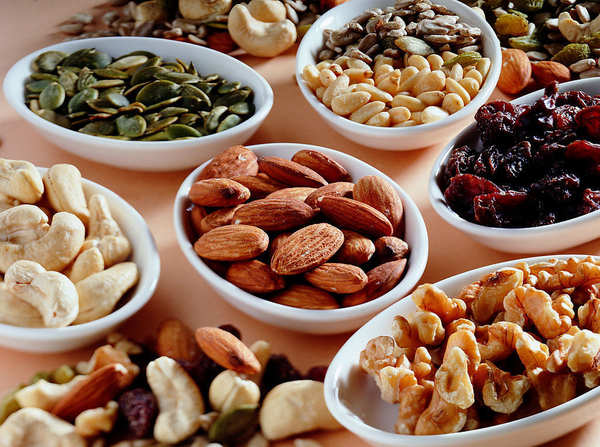(单词翻译:单击)
听力文本
This is Scientific American — 60-Second Science. I'm Christopher Intagliata.
Your nose may be the first place you think of as a source of mucus. But mucus is a major player in your gut, too. "There's antimicrobial peptides and proteins that are present in there. Bacteria live in there and forage on the carbohydrates. And it's a lubricant, it helps sweep contents down the GI tract, without injuring the epithelial layer."
Eric Martens, a microbiologist at the University of Michigan. He says farther down the GI tract, in the colon, the mucus builds a wall: a barrier against friendly bacteria, "as well as pathogens that could be transiting through." But here's the problem: your gut bacteria may chew right through that wall—if you skimp on fiber in your diet.
Martens and his team modeled that scenario in mice who'd been born free of microbes. They seeded the mice's guts with a human gut microbiome—then fed them a high-fiber diet: raw milled corn, whole wheat, whole soybeans and oats. "It's about as raw of a diet as you can get." The human equivalent: double our recommended daily intake of fiber. "It's a lot of kale."

That extreme high-fiber diet helped keep the mucus barrier intact. But in mice that had zero fiber—or the kind of soluble fiber typically added to processed foods—the fiber-eating members of the gut dwindled. Their absence opened up more real estate for mucus-munching bacteria, which boomed in number, and tore through the protective mucus wall—leaving intestinal cells open for microbial attack. The study is in the journal Cell.
The results suggest that "the recent history of your diet could predispose how you react to an enteric pathogen." And they're yet another endorsement of the magical properties of plant fiber. "Eating natural vegetables, raw vegetables, cooked veggies, whole grains, is definitely good for you." The good news is, the mice's gut bacteria bounced back within a day to a change in diet. So eat for the gut you want. Not the gut you have.
Thanks for listening for Scientific American — 60-Second Science Science. I'm Christopher Intagliata.
参考译文
这里是科学美国人——60秒科学。我是克里斯托弗·因塔利亚塔。
对于粘液的来源,你想到的第一个地方可能就是鼻子。但是粘液也是肠道中的重要成分。“肠道中有抗菌肽和蛋白质。肠道中的细菌以碳水化合物为食。肠道中的粘液是一种润滑剂,它可以帮助食物沿胃肠道滑下,而不损伤上皮层细胞。”
埃里克·马顿斯是密歇根大学的微生物学家。他表示,在胃肠道下方,粘液在结肠处建造了一堵墙:这个屏障可以抵抗友善的细菌以及病原体通过。但是问题是:如果你的饮食中缺少膳食纤维,那肠道细菌也可能会穿过那堵墙。
马斯顿和他的团队用老鼠进行情况模拟,这些老鼠生来不含有任何微生物。他们在老鼠的肠道内植入人体肠道的微生物,然后给老鼠喂纤维含量高的饮食:生玉米碎、全麦、大豆和燕麦。“这基本上和人类食物的原料类似。”相当于人类的饮食:将摄入的纤维量翻倍。“这是大量的甘蓝。”
纤维含量极高的饮食有助于保持粘液屏障的完整性。但是,老鼠体内没有任何纤维,也没有通常会添加到加工食品中的可溶性纤维,肠道中以纤维为食的细菌数量减少。纤维细菌的缺乏则为粘液细菌提供了更多场所,造成粘液细菌数量激增,然后通过保护的黏膜墙,导致肠道细胞易受到微生物的攻击。该研究结果发表在《细胞》期刊上。
研究结果表明,“你最近的饮食可以反应出你如何应对肠道病菌。”它们也反应了植物纤维的神奇特性。“吃天然的蔬菜、生蔬菜、熟蔬菜、全谷物,绝对是对你有好处的。” 好消息是,老鼠的肠道细菌在改变饮食一天以后迅速恢复了活力。所以,要食用你的肠道告诉你要吃的食物,而不是你的直觉告诉你要吃的食物。
谢谢大家收听科学美国人——60秒科学。我是克里斯托弗·因塔利亚塔。
译文为可可英语翻译,未经授权请勿转载!
重点讲解
重点讲解:
1. skimp on 草率地做;马马虎虎地做;节俭使用;节省;
例句:Many families must skimp on their food and other necessities just to meet the monthly rent.
就为了交齐每月的租金,许多家庭不得不省吃俭用。
2. add to 添加;增加;掺加;
例句:The interest is added to your account every year.
利息每年都加到您的存款中。
3. open up (使)(机会、可能性等)出现;(使)产生;
例句:Night hiking opens up a new world to visitors.
夜游则让游客置身一个全新世界。
4. react to (作出)反应;回应;
例句:They say children will react to what they see.
他们说孩子会对他们看到的做出反应。


